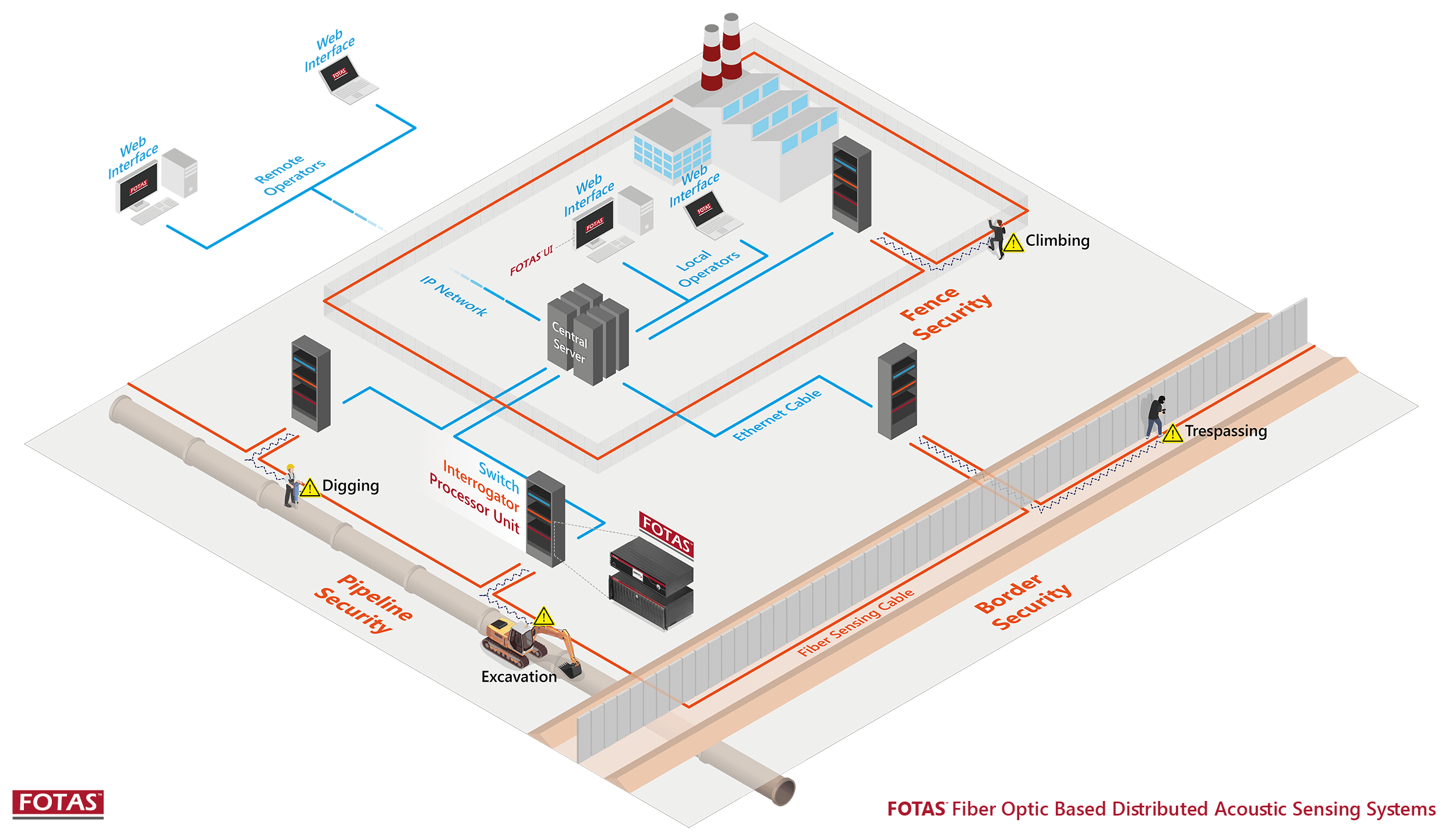How a Fiber Security System Provides Unmatched Dependability and Speed in Security Surveillance
The Ultimate Overview to Fiber Optic Safety Solutions for Your Company
In an era where safety problems are extremely important for businesses, understanding the complexities of fiber optic innovation can be transformative. This overview details how incorporating fiber optic protection systems not only boosts information protection yet also uses advantages like resistance to interference and real-time monitoring abilities.
Recognizing Fiber Optic Technology

The core of a fiber optic cord contains a slim glass or plastic facility, bordered by a cladding layer that reflects light back right into the core. fiber optic security system. This style guarantees marginal loss of signal strength, even over substantial ranges. There are 2 key kinds of fiber optic cords: single-mode and multi-mode. Single-mode fibers are designed for long-distance transmission, while multi-mode fibers appropriate for much shorter ranges, frequently used within structures.
Optical fiber are not only much faster however also extra safe and secure than conventional electrical wiring. Their inherent resistance to electro-magnetic interference and the problem of taking advantage of the signal without detection make them a preferred selection for businesses focusing on data stability and safety. As organizations increasingly rely upon safe and secure and reliable communication systems, understanding fiber optic innovation becomes essential for informed decision-making.
Secret Benefits of Fiber Optic Security
When taking into consideration safety alternatives for an organization, the advantages of fiber optic systems are particularly engaging. First and foremost, fiber optic modern technology offers phenomenal information transmission rates and bandwidth capability, making it suitable for handling high-resolution video feeds from surveillance video cameras. This ability guarantees that safety workers receive real-time data, enhancing total feedback times to possible security hazards.
Furthermore, fiber optic wires are inherently immune to electromagnetic interference, which can compromise the integrity of standard copper-based systems. This resistance makes certain that the information sent stays safe and secure and uninterrupted, providing a much more dependable security infrastructure. Furthermore, fiber optics are much less prone to physical damages, as they are made from glass instead of steel, decreasing upkeep costs and downtime.
Fiber optic systems provide enhanced cybersecurity features, including file encryption abilities that shield sensitive information from unauthorized accessibility. Collectively, these benefits make fiber optic security systems a durable option for businesses seeking to improve their security measures.
Setup Refine and Considerations
Considering the complexities involved, the setup process of fiber optic protection systems requires mindful planning and implementation. The preliminary step entails an extensive site assessment to recognize optimum places for cabling and devices. This assessment must think about ecological elements, existing facilities, and possible vulnerabilities.

In addition, the installment must abide by regional building ordinance and sector standards. This may include collaborating with numerous stakeholders such as building managers, IT teams, and protection workers to make certain seamless combination with existing systems.
Post-installation, rigorous screening is essential to confirm system performance and determine any type of concerns that may arise. By focusing on these considerations throughout the installment process, companies continue reading this can make certain a robust and effective fiber optic security system that fulfills their specific protection requirements.
Latest Developments in Fiber Optic Protection
Current developments in fiber optic technology have considerably boosted the abilities of safety and security systems for organizations. One of one of the most remarkable technologies is the assimilation of fiber optic sensors that can identify resonances and invasions along the boundary of a center. These sensors offer real-time monitoring, enabling quick reaction to potential breaches.
In addition, the advancement of dispersed fiber optic picking up technology permits the continual surveillance of large locations with a solitary fiber cord. This technique not only minimizes installment expenses however additionally enhances the integrity of keeping an eye on systems by removing the requirement for multiple, separate sensors.
Additionally, improvements in multiplexing techniques have allowed services to send large amounts of information over fiber optic networks, enhancing the abilities of video clip security systems. High-definition video feeds can currently be sent out over fars away without loss of high quality, making certain that safety and security personnel have accessibility to clear and workable information.
Lastly, making use of expert system (AI) together with fiber optic systems is reinventing hazard discovery. AI algorithms can examine information from fiber optic networks to determine uncommon patterns or habits, enabling positive safety procedures. These innovations jointly represent a significant jump onward in fiber optic safety modern technology.
Selecting the Right System for Your Service
Selecting the proper fiber optic safety system for your business is critical for guaranteeing ideal security and peace of mind. To make an enlightened option, analyze your details safety requirements, thinking about factors such as the size of your premises, the nature of your procedures, and possible vulnerabilities.
Begin by assessing the level of security needed; for example, high-risk settings might require sophisticated systems with incorporated monitoring and invasion detection abilities. Next, consider scalability; as your business grows, your security system should can increasing to accommodate Find Out More increased needs without significant overhauls.
In addition, check out the dependability and efficiency of different systems. Try to find carriers with established reputations and consumer endorsements that vouch for their solution high quality. It's likewise a good idea to ask about the read this modern technology's compatibility with existing facilities, making certain a smooth combination procedure.
Conclusion
In conclusion, fiber optic safety systems provide a robust remedy for boosting organization safety and security infrastructures. The most current innovations additionally reinforce the performance of these systems, making sure that services stay protected and adaptable in an ever-evolving risk landscape.